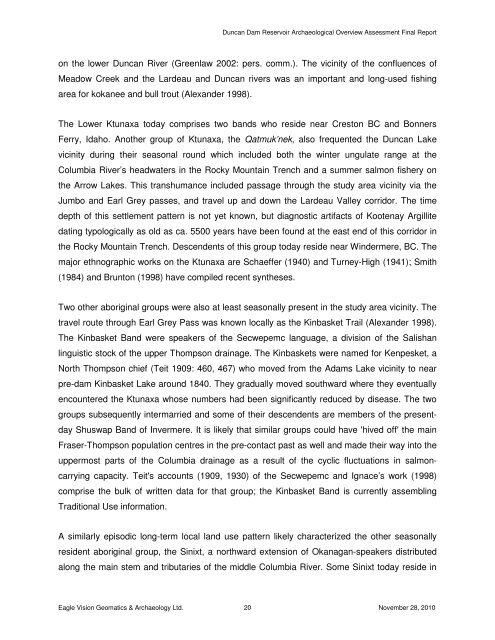November 2010 - BC Hydro
November 2010 - BC Hydro
November 2010 - BC Hydro
You also want an ePaper? Increase the reach of your titles
YUMPU automatically turns print PDFs into web optimized ePapers that Google loves.
Duncan Dam Reservoir Archaeological Overview Assessment Final Report<br />
on the lower Duncan River (Greenlaw 2002: pers. comm.). The vicinity of the confluences of<br />
Meadow Creek and the Lardeau and Duncan rivers was an important and long-used fishing<br />
area for kokanee and bull trout (Alexander 1998).<br />
The Lower Ktunaxa today comprises two bands who reside near Creston <strong>BC</strong> and Bonners<br />
Ferry, Idaho. Another group of Ktunaxa, the Qatmuk’nek, also frequented the Duncan Lake<br />
vicinity during their seasonal round which included both the winter ungulate range at the<br />
Columbia River’s headwaters in the Rocky Mountain Trench and a summer salmon fishery on<br />
the Arrow Lakes. This transhumance included passage through the study area vicinity via the<br />
Jumbo and Earl Grey passes, and travel up and down the Lardeau Valley corridor. The time<br />
depth of this settlement pattern is not yet known, but diagnostic artifacts of Kootenay Argillite<br />
dating typologically as old as ca. 5500 years have been found at the east end of this corridor in<br />
the Rocky Mountain Trench. Descendents of this group today reside near Windermere, <strong>BC</strong>. The<br />
major ethnographic works on the Ktunaxa are Schaeffer (1940) and Turney-High (1941); Smith<br />
(1984) and Brunton (1998) have compiled recent syntheses.<br />
Two other aboriginal groups were also at least seasonally present in the study area vicinity. The<br />
travel route through Earl Grey Pass was known locally as the Kinbasket Trail (Alexander 1998).<br />
The Kinbasket Band were speakers of the Secwepemc language, a division of the Salishan<br />
linguistic stock of the upper Thompson drainage. The Kinbaskets were named for Kenpesket, a<br />
North Thompson chief (Teit 1909: 460, 467) who moved from the Adams Lake vicinity to near<br />
pre-dam Kinbasket Lake around 1840. They gradually moved southward where they eventually<br />
encountered the Ktunaxa whose numbers had been significantly reduced by disease. The two<br />
groups subsequently intermarried and some of their descendents are members of the present-<br />
day Shuswap Band of Invermere. It is likely that similar groups could have 'hived off' the main<br />
Fraser-Thompson population centres in the pre-contact past as well and made their way into the<br />
uppermost parts of the Columbia drainage as a result of the cyclic fluctuations in salmon-<br />
carrying capacity. Teit's accounts (1909, 1930) of the Secwepemc and Ignace’s work (1998)<br />
comprise the bulk of written data for that group; the Kinbasket Band is currently assembling<br />
Traditional Use information.<br />
A similarly episodic long-term local land use pattern likely characterized the other seasonally<br />
resident aboriginal group, the Sinixt, a northward extension of Okanagan-speakers distributed<br />
along the main stem and tributaries of the middle Columbia River. Some Sinixt today reside in<br />
Eagle Vision Geomatics & Archaeology Ltd. 20 <strong>November</strong> 28, <strong>2010</strong>

















